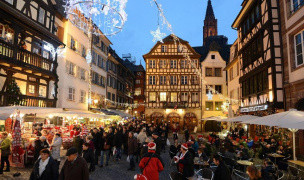 4 Terms
4 TermsHome > Terms > English (EN) > black church and spirituality
black church and spirituality
For centuries black Christian churches have functioned as important religious, political and social institutions for African Americans in the United States. To date there are seven major black Christian denominations in the United States: African Methodist Episcopal (AME), African Methodist Episcopal Zion (AMEZ), Christian (formerly Colored) Methodist Episcopal (CME), National Baptist Convention, USA., Inc., National Baptist Convention of America, Progressive National Baptist Convention and the Church of God in Christ (COGIC). Historically these churches functioned as safe havens from the social ills of slavery political disenfranchisement, segregation and urban displacement. As some of the few autonomous black institutions in the United States, African American Christian churches served as mediators between an oppressed community’s public struggles for full citizenship and its private efforts to maintain selfrespect and self-determination.
Some scholars contend that the seeds of the modern black church were planted during the early period of enslavement. During this time, enslaved African Americans received their initial introduction to Christianity from Protestant missionary societies such as the Society for the Propagation of the Gospel in Foreign Parts (1701) and later from the evangelical activities of the Awakenings. Rather than embrace a Christian theology that justified their enslavement and legitimized their obedience, enslaved African Americans sought to create a theology reflecting their own interpretation of Christianity. Within this distinct understanding of Christianity, African Americans encompassed various forms of resistance. For enslaved communities, engaging in collective religious worship was in itself an act of resistance. African Americans gathered in densely forested areas or “hush harbors” for secret worship services. Secluded from the ears of their slave masters, they preached against the institution of slavery worshipped in their own African-derived styles and prayed for their freedom. Within this “invisible institution,” African Americans formulated a unique religiosity that would come to embody in part, the spiritual substance of black churches.
As Christianity developed among enslaved and free blacks in the eighteenth and nineteenth centuries, debates in American culture focused on the efficacy of Christianity in creating communities of docile or rebellious African Americans. Slave rebellions closely connected to Christianity and black religious institutions began to surface in the first half of the nineteenth century. The potent combination of Christianity and resistance fueled the Southern insurrection plans of Gabriel Prosser in 1800, Denmark Vesey in 1822, and Nat Turner in 1831. Despite these prominent examples of religion and resistance, it remains largely inconclusive to what extent Christianity made African Americans more accommodative to or resistant against their oppressed social situations.
What is conclusive, however, is that Christianity became a forum for exercising levels of autonomy and independence.
African Americans expressed their autonomy through the formation of independent black churches. Between 1773 and 1775 the earliest known separate black Christian church was established by an enslaved African American, George Liele, in Silver Bluff, South Carolina. Converted within this black Baptist community in Silver Bluff was another enslaved African American, Andrew Bryan, who later established the First African Church in Savannah in 1788. By 1830 this church housed some 2,417 free and enslaved black members. The eighteenth century also marked the rise of independent black Christian churches in the North. The independent church movement among free black Methodists in the North gave rise to the first separate African American Christian denomination in the United States. Although other historical churches such as the African Methodist Episcopal Zion Church (1801) and the Christian (formerly Colored) Methodist Episcopal Church (1870) helped to comprise the total body of black Methodists in the United States, the African Methodist Episcopal Church had by far the greatest appeal among African Americans. Established by an ex-slave, Richard Allen, in 1787 as an independent church in Philadelphia, PA and in 1816 as a separate black denomination, the African Methodist Episcopal Church quickly evolved into a network of black Methodist churches that extended into other states such as Maryland, Delaware and New Jersey This new black denomination had as its collective mission abolitionism, racial unity, mutual aid and education. Several nineteenth-century colleges such as Wilberforce, Morris Brown, Allen, Paul Quinn and Shorter Junior College were, in fact, founded under the auspices of the AME church. As a direct result of its missionary endeavors in the South throughout the nineteenth century the AME church was able to increase its pre-Civil War membership of 20,000 people to almost a half million in 1896.
Its current membership stands at over 2 million of a total black Methodist membership of some 4 million, thus making black Methodists second in number only to the black Baptists (10 million) among black Christians in the United States. Within this context of black Christian membership, the rise of black Pentecostalism in the early twentieth century would eventually give birth to the third largest black Christian denomination in the United States, the Church of God in Christ (1907), with a current membership of over 3 million.
Although African American Baptists, Methodists and Pentecostals comprise a large majority of the black religious bodies in the United States, these Christian denominations by no means exhaust the historical diversity of black spirituality. Existing alongside these Christian denominations have always been alternative spiritual traditions that utilize African-derived rituals and folk beliefs as primary sources of power. During slavery the hidden services of the “hush harbors” coexisted in enslaved communities with the presence of African conjure. The practices of conjure, often used interchangeably with “hoodoo,” mirrored African rituals of divination, charm production and “root-work” or herbalism. Conjure and “hoodoo” created a space for the power of human agency within an elaborate spiritual world of spirits, ancestors, charms, divination and folklore. The coexistence of these two systems of religious thought are a direct reflection of the historical complexity of black religious identity. Historically these alternative spiritual orientations were heavily concentrated throughout the southern US in places like New Orleans, Louisiana and the low country and sea islands of South Carolina and Georgia.
More recent expressions of African-derived spiritualities include traditional Congo, Akan and Yoruba-inspired traditions such as Santería (Ocha) and Voudou. Many of these recent traditions developed in the United States largely as a result of the efforts of African and African Caribbean immigrants, indigenous cultural and political nationalist movements in the 1960s and transatlantic travel to Africa on the part of African Americans. Although many of these recent traditions are not directly linked to the historical phenomenon of conjure/hoodoo in the US, they do possess a shared African orientation that remains significantly pronounced in black religiosity.
- Part of Speech: noun
- Synonym(s):
- Blossary:
- Industry/Domain: Culture
- Category: American culture
- Company: Routledge
- Product:
- Acronym-Abbreviation:
Other Languages:
Member comments
Terms in the News
Billy Morgan
Sports; Snowboarding
The British snowboarder Billy Morgan has landed the sport’s first ever 1800 quadruple cork. The rider, who represented Great Britain in the 2014 Winter Olympics in Sochi, was in Livigno, Italy, when he achieved the man-oeuvre. It involves flipping four times, while body also spins with five complete rotations on a sideways or downward-facing axis. The trick ...
Marzieh Afkham
Broadcasting & receiving; News
Marzieh Afkham, who is the country’s first foreign ministry spokeswoman, will head a mission in east Asia, the state news agency reported. It is not clear to which country she will be posted as her appointment has yet to be announced officially. Afkham will only be the second female ambassador Iran has had. Under the last shah’s rule, Mehrangiz Dolatshahi, a ...
Weekly Packet
Language; Online services; Slang; Internet
Weekly Packet or "Paquete Semanal" as it is known in Cuba is a term used by Cubans to describe the information that is gathered from the internet outside of Cuba and saved onto hard drives to be transported into Cuba itself. Weekly Packets are then sold to Cuban's without internet access, allowing them to obtain information just days - and sometimes hours - after it ...
Asian Infrastructure Investment Bank (AIIB)
Banking; Investment banking
The Asian Infrastructure Investment Bank (AIIB) is an international financial institution established to address the need in Asia for infrastructure development. According to the Asian Development Bank, Asia needs $800 billion each year for roads, ports, power plants or other infrastructure projects before 2020. Originally proposed by China in 2013, a signing ...
Spartan
Online services; Internet
Spartan is the codename given to the new Microsoft Windows 10 browser that will replace Microsoft Windows Internet Explorer. The new browser will be built from the ground up and disregard any code from the IE platform. It has a new rendering engine that is built to be compatible with how the web is written today. The name Spartan is named after the ...
Featured Terms
Saab Gripen
The Saab Gripen is a lightweight single-engine multirole fighter manufactured by the Swedish aerospace company Saab. It is a low-cost, low maintenance ...
Contributor
Featured blossaries
Browers Terms By Category
- Algorithms & data structures(1125)
- Cryptography(11)
Computer science(1136) Terms
- Bread(293)
- Cookies(91)
- Pastries(81)
- Cakes(69)
Baked goods(534) Terms
- Skin care(179)
- Cosmetic surgery(114)
- Hair style(61)
- Breast implant(58)
- Cosmetic products(5)
Beauty(417) Terms
- Aeronautics(5992)
- Air traffic control(1257)
- Airport(1242)
- Aircraft(949)
- Aircraft maintenance(888)
- Powerplant(616)
Aviation(12294) Terms
- Railroad(457)
- Train parts(12)
- Trains(2)





